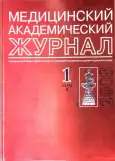Стереотактическое протонное облучение аденом гипофиза - опыт ФГУ РНЦРХТ Росмедтехнологий
- Авторы: Гранов А.М.1, Виноградов В.М.1, Шалек Р.А.1, Ялыныч Н.Н.1, Карлин Д.Л.1, Пушкарева Т.В.1, Копанева М.В.1
-
Учреждения:
- ФГУ «Российский научный центр радиологии и хирургических технологий»
- Выпуск: Том 8, № 1 (2008)
- Страницы: 60-68
- Раздел: Статьи
- Статья опубликована: 08.03.2008
- URL: https://journals.eco-vector.com/MAJ/article/view/693019
- ID: 693019
Цитировать
Полный текст
Аннотация
В статье обсуждаются результаты стереотактического радиохирургического протонного облучения аденом гипофиза. С 1975 г. 464 пациента с различными клиническими проявлениями подверглись лучевому воздействию на синхроциклотроне ПИЯФ (1000 МэВ, г. Гатчина). Ввиду высокой энергии генерируемого пучка, использовался ротационноконвергентный метод облучения «напролет». Оно было однократным в дозе 80-100 Гр. При пролактинсекретирующих аденомах излечение отмечено у 80% пациентов, стабилизация - в 15% случаев. У 21 пациентки наступившие беременности закончились рождением здоровых детей. Полная клиническая ремиссия наблюдалась у 92% больных с болезнью Иценко-Кушинга и проявлялась исчезновением сахарного диабета, нормализацией показателей артериального давления и регрессом патологического ожирения. Стойкое излечение и полная нормализация показателей соматотропного гормона (СТГ) отмечались в отдаленные сроки наблюдения у 86% больных соматотропиномами. При любой клинической форме аденом гипофиза к пятому году наблюдения отмечалось достоверное снижение уровней патологически повышенных гормонов. При этом у подавляющего числа пациентов не отмечено развития вторичной гормональной недостаточности. Клиническое излечение при гормонально-неактивных аденомах составило 95%. Проведение протонного облучения не сопровождалось серьезными, а тем более угрожающими жизни осложнениями. Авторы приходят к выводу, что облучение эндоселлярных аденом гипофиза протонным пучком по разработанной методике является безопасным, высокоэффективным, а в ряде случаев и единственно возможным методом лечения.
Ключевые слова
Об авторах
А. М. Гранов
ФГУ «Российский научный центр радиологии и хирургических технологий»
Автор, ответственный за переписку.
Email: shabanov@mail.rcom.ru
академик РАМН
Россия, Санкт-ПетербургВ. М. Виноградов
ФГУ «Российский научный центр радиологии и хирургических технологий»
Email: shabanov@mail.rcom.ru
Россия, Санкт-Петербург
Р. А. Шалек
ФГУ «Российский научный центр радиологии и хирургических технологий»
Email: shabanov@mail.rcom.ru
Россия, Санкт-Петербург
Н. Н. Ялыныч
ФГУ «Российский научный центр радиологии и хирургических технологий»
Email: shabanov@mail.rcom.ru
Россия, Санкт-Петербург
Д. Л. Карлин
ФГУ «Российский научный центр радиологии и хирургических технологий»
Email: shabanov@mail.rcom.ru
Россия, Санкт-Петербург
Т. В. Пушкарева
ФГУ «Российский научный центр радиологии и хирургических технологий»
Email: shabanov@mail.rcom.ru
Россия, Санкт-Петербург
М. В. Копанева
ФГУ «Российский научный центр радиологии и хирургических технологий»
Email: shabanov@mail.rcom.ru
Россия, Санкт-Петербург
Список литературы
- Минакова Е. И., Кирпатовская Л. Е., Бельченко Л. В., Шилина А. В. Результаты протонной и гамма-терапии при болезни Иценко-Кушинга // Мед. радиол. 1990. № 9. С. 33-39.
- Серпуховитш С. Ю., Кирпатовская Л. Е., Комолов И. С. Современные методы лечения аденом гипофиза//Пробл. эндокрнпол. 1995. Т. 41. С. 26-29.
- AbrosimovN., Gavrikov Yu., Ivanov Е. et al. 1000 MeV Proton beam therapy facility at Petersburg Nuclear Physics Institute // Synchrocyclotron J. of Physics; Conference Series. 2006. Vol. 1. P. 424—432.
- AsthagiriA., Lopes M. B. Neuropathological consider¬ations of pituitary adenomas // Front Horm Res. 2006. Vol. 34. P. 206-235.
- Elster A. D. Modern imaging of the pituitary // Radiology. 1993. Vol. 187. P. 1-14.
- GranovA., Vinogradov V., Karlin D. etal. Stereotactic proton beam radiosurgery at Saint-Petersburg // HCPBM 10 th Workshop on Heavy charged particles in biology and medicine and ENLIGHT 4th Meeting of the European network for light ion hadron therapy. Oropa ( Biella) 15—19 June 2005. P. 67-69.
- HeljicB., BurekovicA., IglicaA. Evaluation of the tumor of the pituitary gland (hypophysis) between 2000-2005. On the intensive care of The Endocrinology Clin¬ic of the Clinical Center of the University of Sarajevo // Med. Arh. 2006. Vol. 60. № 3. P. 175-178.
- KabilM. S., Eby J. B., Shahinian H. К Fully endoscopic endonasal vs. transseptal transsphenoidal pituitary surgery // Minim Invasive Neurosurg. 2005. Dec. Vol. 48 (6). P. 348-54.
- Liu J. K, Cohen-Gadol A. A., Laws E. R Jr. etal. Harvey Cushing and Oskar Hirsch: early forefathers of modern transsphenoidal surgery II J. Neurosurg. 2005. Dec. Vol. 103 (6) P. 1096-1104.
- Meldos S. Medical management of acromegaly-what end when? //Acta Endocrinol. 1993. Vol. 129 (Suppl. 1.1). P. 13.
- Moreno C. S., Evans С. O., Zhan X. et al. Novel molecular signaling and classification of human clinically nonfunctional pituitary adenomas identified by gene expression profiling and proteomic analyses H Cancer Res. 2005. Nov 15. Vol. 65. № 22. P. 10214-10222.
- Plowman P. N. Radiotherapy for pituitary tumors // 1995. Vol. 9. P 407-420.
- Scacchi M., Cavagnini F. Acromegaly II Pituitary. 2006. Vol. 9 (4). P. 297-303.
- Sheehan J. P, Jagannathan J., Pouratian N., Steiner L. Stereotactic radiosurgery for pituitary adenomas: a review of the literature and our experience // Front Horm Res. 2006. Vol. 34. P. 185-205.
- Shin M. Gamma knife radiosurgery for pituitary adenoma // Biomed Pharmacother. 2002. Vol. 56 (Suppl. I). P. 178-181.
- Vinogradov V, Karlin D., Yalynich N., Shalek R Our experience of proton beam radiosurgery at Saint-Petersburg // Radioterapy and oncology. 2006. Vol. 81 (Suppl . 1). P. 81.
Дополнительные файлы






